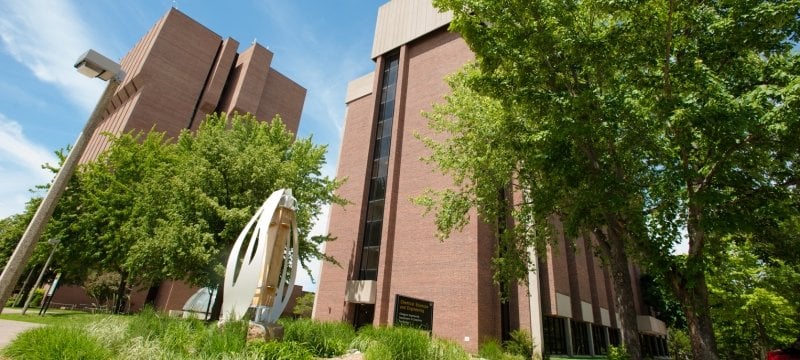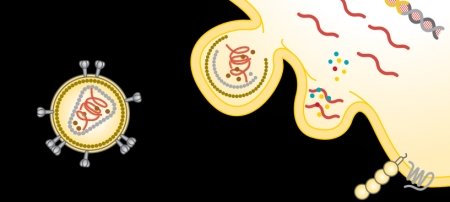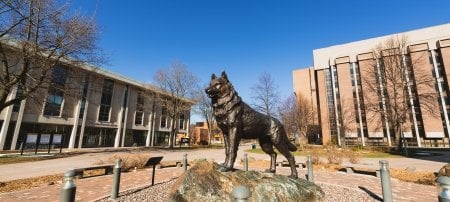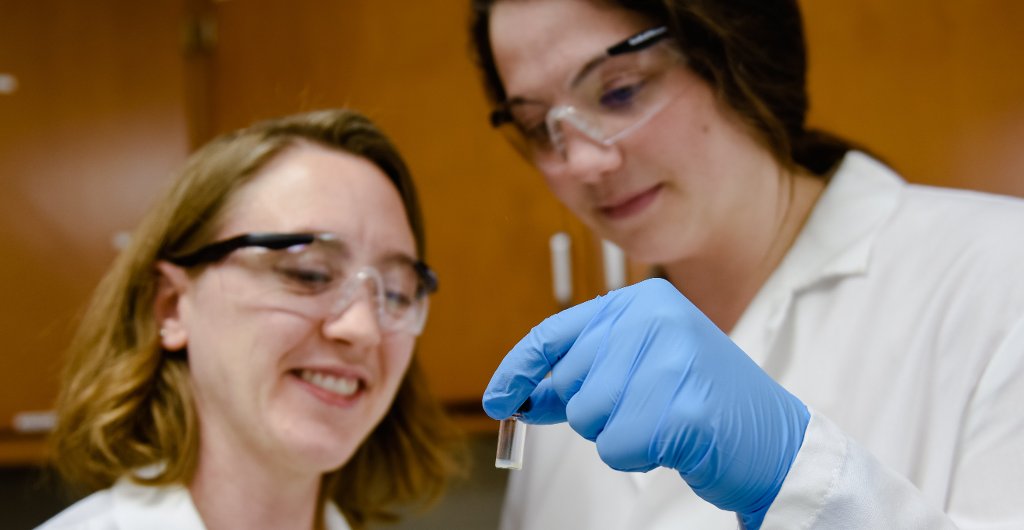A collaborative innovation in microfluidics reveals graduate excellence and outstanding mentorship as well as the secrets of viruses.
Michigan Technological University’s Bhakta Rath Research Award honors exceptional work and collaboration between a doctoral student and their advisor. This year, chemical engineering takes the spotlight as Sanaz Habibi and Adrienne Minerick share the honor.
Habibi, who graduated in 2019, is now working on a postdoc at the University of Michigan focused on optical 3D printing anatomical parts and devices that expands on those she helped develop at Michigan Tech. Minerick, dean of the College of Computing, also has a faculty appointment in the Department of Chemical Engineering where she has studied how to use electric fields to better understand biological processes.
Viruses respond to such fields. Within a carefully constructed microfluidics device, it is possible to observe a virus attach to and infect a live cell as the inner workings turn into a viral genetics factory that eventually bursts apart. The team, whose work on observing the viral infection cycle with microfluidics was recently published in Langmuir, exemplifies nontraditional collaboration and thinking outside the box — even when their creativity centers on a three-by-one-inch microscope slide.
In this Q&A, Habibi (SH) and Minerick (AM) share details on their work and work styles.
"It is great to see such strong graduate student research accomplishments — and no surprise given the strong mentoring from Dr. Minerick."
Q: What’s your project about?
SH: Long before the pandemic, we became interested in studying viruses. We designed a carefully controlled study to look at how the virus attacks the host cell. We studied the interaction between the virus and cell in relation to time using microfluidic devices. We showed we could see the time-dependent interactions in an electric field.

AM: This built on our prior work: We could discern molecules on the surface of red blood cells. Now we looked at a virus, specifically the outer shell of proteins called the capsid. A virus attaches to a cell based on its specific capsid proteins, then proceeds to enter the cell and hijack it to make its own genetic material using the cellular machinery. Our electrokinetic technique focused on membrane activity, although it also could discern intercellular processes, too.
Thinking through controls for this study took a lot of planning. We used pig kidney cells, PK-13, infected with a parvovirus that causes reproductive issues in pigs and doesn’t affect humans. Standard procedures require high-tech instruments like fluorescent or scanning electron microscopes. But our technique is lower-tech and we were able to tell stages in the viral cycle. To watch for the infection, Sanaz had to think about the sample time in the microfluidic device, number of cells, cell infection, and how to feasibly complete the experiments every two hours for 10 hours total.
SH: (laughs) One of our reviewers asked why we only watched the infection for 10 hours instead of longer. The experiment meant my fellow graduate collaborators and I had to stay in the lab the whole time. There were many times we stayed longer than 12 hours and we left after midnight more than a few times.
Q: Where did you get the idea?
SH: Our weekly group meeting. In Dr. Minerick’s group, every member gives a research update to the team each week. These weekly meetings helped me significantly shape my PhD objectives. A lot of new ideas formed during these meetings. For instance, Jeana Collins, Hector Moncada and I collaborated on a project to make a lab-on-a-chip clear and biocompatible.
The idea for studying viruses also evolved from lunchtime conversations. Pratik Joshi works with Dr. Caryn Heldt and during lunch we had discussions, sharing what we knew about our own fields in microfluidics and cell culture. We started to discuss how we could collaborate. I told Dr. Minerick, we set up a time with Dr. Heldt, and the four of us planned out the project.
"This revelation is important because it demonstrates that cell signaling inside the cell takes place very early in the infection cycle and can be used as either a detection method (as demonstrated with the method developed by Sanaz) or the signaling pathway can be elucidated and used as a drug target for antiviral compounds. This project would have never come to be if Sanaz had not insisted on working outside of her research group."
Q: How have your methods and approach helped make the project successful?
AM: Sanaz was in a unique position as a doctoral student; I was serving in administrative roles, which meant less personalized attention, so she had to optimize planning and coordination. We basically wrote papers together in one- to two-hour chunks. It’s a different experience than a traditional PhD.
SH: I know Dr. Minerick’s time was precious because of her appointments, but she made sure that I had enough time to interact with her. She would set aside specific time for me after work hours. She made time for me. Not many advisors would do that.
AM: In my initial talk with Sanaz, I remember thinking, I have nine students in my lab already, how am I going to pull together a meaningful project and get funding? The initial approach we took was to start with missing data from an unfinished project; I handed over data that needed cleaning up. I remember her coming into a meeting and telling me the data wasn’t great — it wasn’t reproducible. She was honest about the data. That’s invaluable. That’s when I knew she was dedicated to the science.
SH: I remember working on the viral study when I almost gave up on the data. I needed Plan C and Plan D. Dr. Minerick listened; she calmed me down. When I proposed another project, a backup, the plan wasn’t as good as the original. So, she advised me on how to troubleshoot the initial project. I looked closely at my procedure and realized there was a missing step. That project is now published and it was strengthened from the collaboration.
Q: Viral infections are top of mind these days. What insights do you have on the pandemic?
AM: Human behavior influences the spread of disease more than viral chemistry. Viruses are maximized to replicate efficiently. Once isolated in a host, human behavior plays a stronger role in it getting to the next host. As an engineer, it’s been interesting to observe viral activity at the cellular level. Our research helps us understand how to use electric fields to understand the stages of infection. We don’t have to rely on fluorescent labeling, which saves time and money to examine virus-cell penetration and each of the infection cycle stages. Technology like this can help us characterize novel viruses as they emerge and how they replicate.
"In assessing the overall standard of PhD research (and its supervision), the key parameters of relevance are its quality, impact, novelty and promise of the candidate’s further work. … I can offer my strongest of recommendations that Dr. Habibi’s research scores highly on all these aspects."
Q: Why do you care about your research?
SH: When you are working with such small particles and organisms it reveals mechanisms that make up life. In microdevices, you’re able to see this process happening in real time. It’s rewarding to track those changes and know it may lead to a novel antiviral treatment.
AM: Over my career, the motivation for me has shifted slightly from the pure research to the people involved. When Sanaz pitched this idea, I recognized that this viral model system could be explored in a new way with our electrokinetic tools and it had the potential to validate our colleague’s findings. Projects like this have become an investment in people as well as discovering new knowledge. This is an investment in Sanaz and the contributions she can make to science throughout her career.
Michigan Technological University is an R1 public research university founded in 1885 in Houghton, and is home to nearly 7,500 students from more than 60 countries around the world. Consistently ranked among the best universities in the country for return on investment, Michigan's flagship technological university offers more than 120 undergraduate and graduate degree programs in science and technology, engineering, computing, forestry, business, health professions, humanities, mathematics, social sciences, and the arts. The rural campus is situated just miles from Lake Superior in Michigan's Upper Peninsula, offering year-round opportunities for outdoor adventure.







Comments